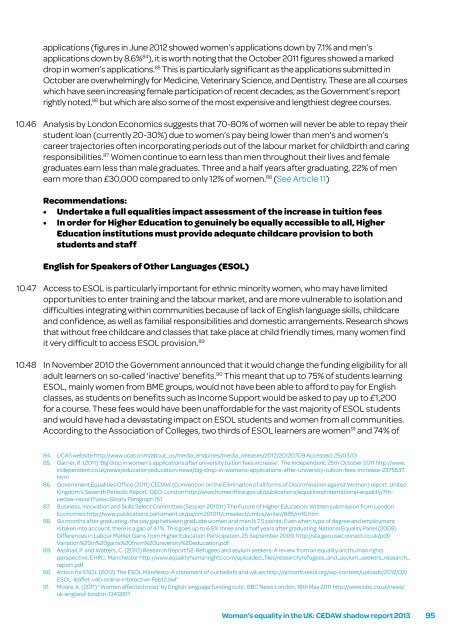Women’s equality in the UK – A health check
Women’s equality in the UK – A health check
Women’s equality in the UK – A health check
Create successful ePaper yourself
Turn your PDF publications into a flip-book with our unique Google optimized e-Paper software.
10.46<br />
10.47<br />
10.48<br />
applications (figures <strong>in</strong> June 2012 showed women’s applications down by 7.1% and men’s<br />
applications down by 8.6% 84 ), it is worth not<strong>in</strong>g that <strong>the</strong> October 2011 figures showed a marked<br />
drop <strong>in</strong> women’s applications. 85 This is particularly significant as <strong>the</strong> applications submitted <strong>in</strong><br />
October are overwhelm<strong>in</strong>gly for Medic<strong>in</strong>e, Veter<strong>in</strong>ary Science, and Dentistry. These are all courses<br />
which have seen <strong>in</strong>creas<strong>in</strong>g female participation of recent decades, as <strong>the</strong> Government’s report<br />
rightly noted, 86 but which are also some of <strong>the</strong> most expensive and lengthiest degree courses.<br />
Analysis by London Economics suggests that 70-80% of women will never be able to repay <strong>the</strong>ir<br />
student loan (currently 20-30%) due to women’s pay be<strong>in</strong>g lower than men’s and women’s<br />
career trajectories often <strong>in</strong>corporat<strong>in</strong>g periods out of <strong>the</strong> labour market for childbirth and car<strong>in</strong>g<br />
responsibilities. 87 Women cont<strong>in</strong>ue to earn less than men throughout <strong>the</strong>ir lives and female<br />
graduates earn less than male graduates. Three and a half years after graduat<strong>in</strong>g, 22% of men<br />
earn more than £30,000 compared to only 12% of women. 88 (See Article 11)<br />
Recommendations:<br />
• Undertake a full equalities impact assessment of <strong>the</strong> <strong>in</strong>crease <strong>in</strong> tuition fees<br />
• In order for Higher Education to genu<strong>in</strong>ely be equally accessible to all, Higher<br />
Education <strong>in</strong>stitutions must provide adequate childcare provision to both<br />
students and staff<br />
English for Speakers of O<strong>the</strong>r Languages (ESOL)<br />
Access to ESOL is particularly important for ethnic m<strong>in</strong>ority women, who may have limited<br />
opportunities to enter tra<strong>in</strong><strong>in</strong>g and <strong>the</strong> labour market, and are more vulnerable to isolation and<br />
difficulties <strong>in</strong>tegrat<strong>in</strong>g with<strong>in</strong> communities because of lack of English language skills, childcare<br />
and confidence, as well as familial responsibilities and domestic arrangements. Research shows<br />
that without free childcare and classes that take place at child friendly times, many women f<strong>in</strong>d<br />
it very difficult to access ESOL provision. 89<br />
In November 2010 <strong>the</strong> Government announced that it would change <strong>the</strong> fund<strong>in</strong>g eligibility for all<br />
adult learners on so-called ‘<strong>in</strong>active’ benefits. 90 This meant that up to 75% of students learn<strong>in</strong>g<br />
ESOL, ma<strong>in</strong>ly women from BME groups, would not have been able to afford to pay for English<br />
classes, as students on benefits such as Income Support would be asked to pay up to £1,200<br />
for a course. These fees would have been unaffordable for <strong>the</strong> vast majority of ESOL students<br />
and would have had a devastat<strong>in</strong>g impact on ESOL students and women from all communities.<br />
Accord<strong>in</strong>g to <strong>the</strong> Association of Colleges, two thirds of ESOL learners are women 91 and 74% of<br />
84. UCAS website http://www.ucas.com/about_us/media_enquiries/media_releases/2012/20120709 Accessed: 25/03/13<br />
85. Garner, R. (2011) ‘Big drop <strong>in</strong> women’s applications after university tuition fees <strong>in</strong>crease’, The Independent, 25th October 2011 http://www.<br />
<strong>in</strong>dependent.co.uk/news/education/education-news/big-drop-<strong>in</strong>-womens-applications-after-university-tuition-fees-<strong>in</strong>crease-2375537.<br />
html<br />
86. Government Equalities Office (2011) CEDAW (Convention on <strong>the</strong> Elim<strong>in</strong>ation of all forms of Discrim<strong>in</strong>ation aga<strong>in</strong>st Women) report. United<br />
K<strong>in</strong>gdom’s Seventh Periodic Report. GEO: London http://www.homeoffice.gov.uk/publications/equalities/<strong>in</strong>ternational-<strong>equality</strong>/7thcedaw-report?view=B<strong>in</strong>ary<br />
Paragraph 151<br />
87. Bus<strong>in</strong>ess, Innovation and Skills Select Committee (Session 201011) The Future of Higher Education: Written submission from London<br />
Economics http://www.publications.parliament.uk/pa/cm201011/cmselect/cmbis/writev/885/m16.htm<br />
88. Six months after graduat<strong>in</strong>g, <strong>the</strong> pay gap between graduate women and men is 7.5 po<strong>in</strong>ts. Even when type of degree and employment<br />
is taken <strong>in</strong>to account, <strong>the</strong>re is a gap of 4.1%. This goes up to 6.5% three and a half years after graduat<strong>in</strong>g. National Equality Panel (2009)<br />
Differences <strong>in</strong> Labour Market Ga<strong>in</strong>s from Higher Education Participation, 25 September 2009. http://sta.geo.useconnect.co.uk/pdf/<br />
Variation%20<strong>in</strong>%20ga<strong>in</strong>s%20from%20university%20education.pdf<br />
89. Asp<strong>in</strong>all, P. and Watters, C. (2010) Research Report 52: Refugees and asylum seekers: A review from an <strong>equality</strong> and human rights<br />
perspective. EHRC: Manchester http://www.<strong>equality</strong>humanrights.com/uploaded_files/research/refugees_and_asylum_seekers_research_<br />
report.pdf<br />
90. Action for ESOL (2012) The ESOL Manifesto: A statement of our beliefs and values http://actionforesol.org/wp-content/uploads/2012/02/<br />
ESOL-leaflet-v4b-onl<strong>in</strong>e-<strong>in</strong>teractive-Feb12.swf<br />
91. Moore, K. (2011) ‘’Women affected most’ by English language fund<strong>in</strong>g cuts’, BBC News London, 18th May 2011 http://www.bbc.co.uk/news/<br />
uk-england-london-13412811<br />
<strong>Women’s</strong> <strong>equality</strong> <strong>in</strong> <strong>the</strong> <strong>UK</strong>: CEDAW shadow report 2013 95


